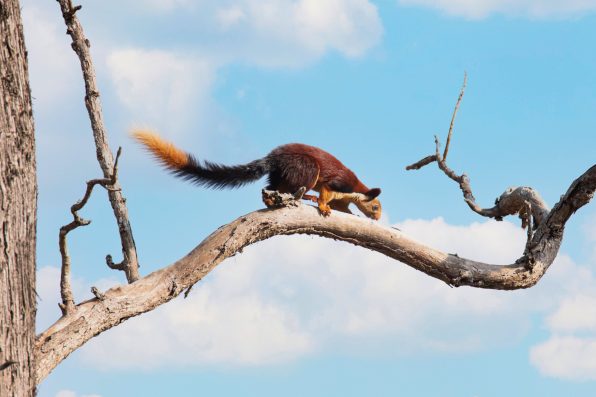Known As The Rainbow Squirrel, This Rodent Species Is Native To India And Sports Fur With A Vibrant Mix Of Orange, Purple, And Maroon Hues

With their bushy tails and acrobatic skills that help them scamper through branches and glide from tree to tree, squirrels have stolen the hearts of many people.
The squirrels most of us know tend to frequent neighborhoods and college campuses. Their coats typically range in shades from rusty red to gray or black.
But did you know there’s a squirrel species out there with fur that contains vibrant orange, pops of purple, and majestic maroon hues?
More than 200 species of squirrels live throughout the world. The most colorful one is the Indian giant squirrel, also known as the rainbow squirrel.
It lives in forests and woodlands across south, central, and eastern India. These creatures are not only the most flamboyant species of squirrels to exist, but they are also the largest.
Indian giant squirrels that are fully grown can reach up to three feet long, including the tail, and weigh nearly five pounds. By comparison, the Eastern gray squirrel, their American cousin, measures up to 22 inches long and weighs about a pound to a pound and a half.
The colorful critters also have round ears and large paws to help them climb. They are capable of leaping as far as 20 feet between trees. Unlike many other squirrels, they create food stores in treetops rather than burying them underground.
Their diets consist of fruit, seeds, leaves, bark, and sometimes, bird eggs and insects. Their predators include snakes, leopards, and birds of prey.
In 1996, Indian giant squirrels were listed as a vulnerable species, but since then, their numbers have risen, and their population has become stable.

fromsham55 – stock.adobe.com – illustrative purposes only, not the actual squirrel
In 2016, a census found that the squirrels had actually experienced an eight percent increase in their population within the districts of Pune and Thane in India.
It is unclear why the rodents boast such bright hues. They are made up of several patches of color. Their stomach and arms are creamy beige, while the rest of their bodies are orange, purple, and red.
The pretty pigments are visually appealing for nature photographers, but aren’t they a liability that gives the squirrels away to predators?
A possible explanation for the vivid shades of the Indian giant squirrel is that they help the animal blend in with the contrasting colors of the forests it lives in. The markings can act as a sort of camouflage, producing the effect of sunlight on dark, shaded areas.
Sign up for Chip Chick’s newsletter and get stories like this delivered to your inbox.
More About:Animals





